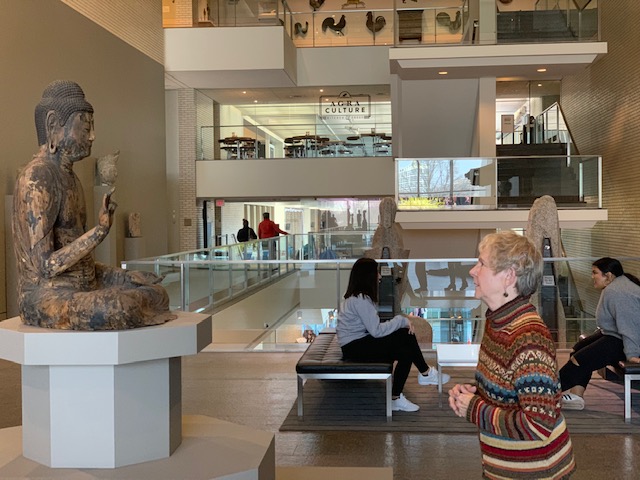Mary Ritten & Kit Wilson - MIA
/Like a second grader, art can sometimes be wiggly, and the path to embracing it can be equally winding.
On weekday mornings, the lobby at the Minneapolis Institute of Arts, or MIA, is buzzing with student groups. Helpful grown ups shout directions over the excitement, hand out name tags, and ride herd so no one wanders off toward medieval armor while the group is headed to 20thcentury photography.
Some of the most helpful grown ups at MIA are the docents. “Docent” comes from the Latin word,docere, meaning “to teach,” and those who earn the docent title at MIA spend two years studying the museum’s collection and instruction techniques while building communication skills to enlighten and excite patrons ranging from kindergarteners to elders.
Two generations of docents, Mary Ritten and Kit Wilson, came to MIA along different paths, but with a similar purpose. Each is a lover of art; one, a practicing artist. Both women credit the power of art – and their experiences at MIA - for revealing their best selves and connecting them, in powerful ways, to community.
Mary, a mother and grandmother, was an early participant in MIA’s docent program and served 18 years before retiring from her docent duties. “I had no background in art,” Mary says. “My youngest child was starting 1stgrade [in 1975] and I finally had some time. I was always a good student. I had 6 children in 8 years. I married right out of college but I needed my own thing. I met a woman at a party who told me about the docent program and something clicked for me. It planted a seed. I took a 4-week class on Jan van Eyck’s altarpiece, The Lamb. I sat in the front row and I asked a lot of questions. The teacher took notice and said ‘Mary, there are others who also don’t know. You are brave for asking. Good for you.’ [As a practicing Catholic], I knew all the saints! At last, I knew something that others didn’t know.”
Kit, the age of Mary’s grown children, has just completed her second year as an MIA docent. She has an art history and fine art background, and likewise found MIA to fill a personal need: “After college,” Kit says, “I tutored at the Princeton Review. I really liked working with kids so I got a teaching license and taught junior high geography. Then I had kids of my own, went on leave, and stayed out a while. I started painting again and showing my art. My art career was growing, but I missed being in a classroom. I don’t like public speaking and I’m terrified speaking in front of grown ups. Working with kids appeals to me.”
Despite the rigors of training and commitment to giving 40 hours of tours per year, docents at MIA are unpaid. “We are professional volunteers,” Mary offers. “They tell us, ‘You are the face of the museum,’ and we are. It’s important we be good, or the patrons will not come back.” The museum relies on volunteers to keep the collection - which is open and free to the public everyday (except Mondays when the building is closed) - accessible to everyone. Mary adds, “When I was an active docent, we had evaluations and annual assessments where the lead docents would follow us around the museum offering critiques and suggestions.” Kit nods in agreement, signaling that the expectations are as high as ever in showcasing the collection to the public, and adds: “They should just ask the guards!” The two women laugh. “They know the pecking order of who is good or isn’t. They listen to everything, they see everything!”
The collection at MIA is huge – some 89,000 art works, from six continents, spanning 20,000 years. Each docent has preferences within the collection, and MIA gives them the freedom to celebrate the pieces they love. The hope is that the personal connection will help patrons connect with the art as well. Kit says, “I go to Renaissance art, and the European pieces with big frames. On my tours I tend toward items I am studying and thinking about so I can drink them in and study them even more.” Mary says she is drawn to the various Buddha statues in MIA’s collection. “I like to go to the Buddha myself and just sit there. That’s where I go to settle. On tours I like the post-Impressionists. They are more solid and not too realistic, but realistic enough, with bold colors. I love the jades, the porcelain, and the [George] Morrison pieces. And Rembrandt’s Lucretia! We have Rembrandt’s bestversion of her.”
Since art resonates with viewers in different ways, both Mary and Kit have learned tricks to present art interpretation as open-ended. “We learned the Visual Inquiry Method,” Mary says. “We don’t tell the kids about the piece, but have them look at the piece first, quietly, and then they tell us what they see. When they offer something, we bring it back to the art and say, ‘What makes you say that?’” “Right,” adds Kit. “Adults want an information dump. Kids like narratives in the pieces, they talk about them as though they are stories and they notice interesting details.“ Mary then adds, “Their perceptions are valid and amazing. They surprise me. I’m not afraid to say ‘I don’t know’ if they ask me a hard question. I don’t bluff. And because I didn’t have an art background when I started here, I don’t use any jargon. In that way, I am just like the visitors.”
When giving tours, both Mary and Kit say it’s important to connect the works of art and the museum to the people of this place. “When I show students our native art collection, I remind them they are standing on Dakota land,” Kit says. “The history of what is in this museum is connected to families of the city,” Mary adds. The land beneath the building is now owned by the Minneapolis Park Board and was donated to the public realm by the Washburn family, known for making their fortune in flour milling. Many pieces in the permanent collection have been gifts to the museum from notable Minneapolitans, and MIA is committed to programming that brings the public in to enjoy them. According to MIA’s website, more than half a million people visit the museum each year, and one hundred thousand students participate in Art Adventures (a partnership between MIA and schools across Minnesota) and through docent-led tours.
“Technology has changed since my day,” Mary assesses, noting the presence of smart phones, iPads and the Internet to access art. “But the art here is real, and makes me think about my world.” Even though she is retired, Mary still attends free lectures and events at MIA that keep her art mind sharp, and she draws energy from the visitors who flood the galleries. As we finish talking, Kit prepares to lead another tour of the museum, this time through the special exhibit on Egyptian treasures from a sunken city. The energy in the museum mounts as groups of children and adults gather in the lobby. “As docents,” Kit says, taking a deep breath and smiling, “we are exhausted after a tour, but also energized.”
For more information: https://new.artsmia.org/
https://grovelandgallery.com/artist/kit-wilson/
Photo credits: Tracy Nordstrom and MIA website









